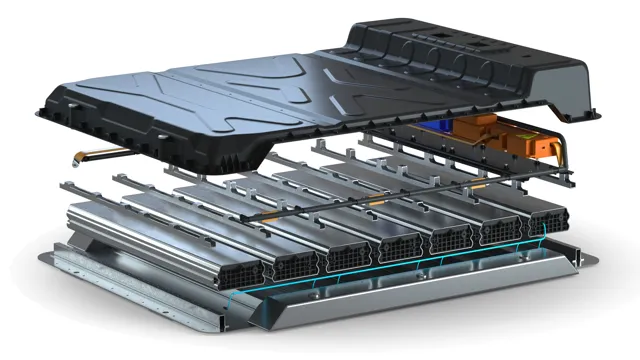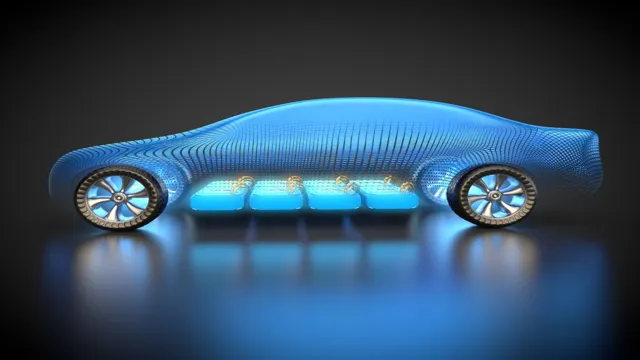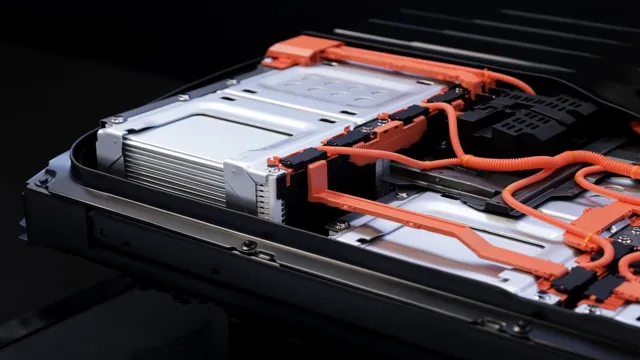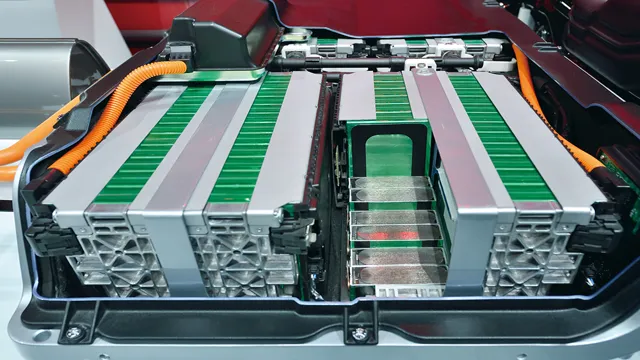Revolutionizing Road Trips: The Latest Breakthrough in Car Battery Technology for Long Distance Electric Vehicles
Electric vehicles have come a long way from being niche gadgets that only a few enthusiasts bought to being a serious contender in the worldwide automotive market. Although their adoption is still lower than traditional vehicles, the gap is shrinking fast. However, to cement their place as the future of transportation, electric vehicles need a breakthrough, a revolutionization that makes them more accessible, convenient, and reliable.
And that time may have come. Revolutionizing electric vehicle travel is a broad term, but it generally refers to the development of better batteries, faster charging infrastructure, and improved driving range. All of these issues are interconnected, and solving one problem can improve the others.
For instance, a better battery can store more energy, which means longer driving range, faster acceleration, and potentially cheaper pricing. Similarly, a faster charging infrastructure can reduce the range anxiety that many EV drivers feel when they are on a long trip. The growing consciousness around climate change and environmental impact is another driving force behind the revolutionization of electric vehicle travel.
As more people switch to electrical vehicles and shun fossil fuel-powered ones, manufacturers are under increasing pressure to deliver better performance, range, and charging speed. Moreover, governments worldwide are rolling out incentives, policies, and regulations that favor electrical cars, which is adding momentum to the revolution. Overall, electric vehicles are poised to become one of the most disruptive technologies in the transportation industry.
The next few years are bound to see some significant breakthroughs that will make them more accessible, reliable, and sustainable. Who knows, the future might herald an age where electric cars rule the road, and their combustion-engine counterparts are relegated to the pages of history.
The Importance of Car Battery Technology
Car battery technology is of utmost importance to the distance that electric vehicles can travel. In the past, the range of electric vehicles was limited by the capacity of their battery. But with the advent of new battery technology, electric vehicles are now able to go as far as traditional cars on a single charge.
This has made electric cars a more practical option for daily commuting and longer road trips. The advancements in battery technology have also made electric vehicles more affordable and easier to maintain. With longer battery life, people are starting to see the benefits of electric cars, which include lowering carbon emissions and contributing to a greener planet.
It’s exciting to see how car battery technology has evolved and will continue to improve in the future, potentially revolutionizing the automotive industry.
Advancements in Battery Life and Efficiency
Car Battery Technology The advancements in battery life and efficiency have become increasingly important in today’s world. The development of car battery technology, in particular, has paved the way for electric vehicles to become a viable mode of transportation. Newer batteries can hold a charge longer and are more energy-efficient than ever before, reducing the need for frequent charging and prolonging the life of the battery.
Improved technology also means that electric vehicles can now go further distances on a single charge, making them more practical for everyday use. The importance of car battery technology in sustainability efforts is evident, as it reduces carbon emissions and helps to preserve the environment. In essence, the advancements in battery technology are critical to the future of transportation, as they make electric vehicles more accessible, convenient, and environmentally friendly.

How Distance Impacts EV Use
As electric cars gain popularity, the importance of car battery technology is becoming increasingly obvious. The limitations of distance and battery life are a significant factor when it comes to how people use their electric vehicles. Depending on the range and charge time of the battery, electric cars may not be suitable for long-distance travel.
This aspect makes electric cars a better fit for city driving, as opposed to extended road trips. However, advancements in battery technology can improve the range and charging time of electric vehicles, making them more practical for longer trips. Ultimately, as car battery technology improves and gains greater efficiency, electric cars will become increasingly accessible and accepted as a viable alternative to traditional gas-powered vehicles.
In summary, while distance is a crucial factor in how electric vehicles are used, the development of car battery technology can address these challenges, increasing the usefulness and popularity of electric cars.
Breaking Down Different EV Battery Types
Car battery technology has come a long way in recent years, especially with the rise of electric vehicles. When it comes to EV battery types, there are several options on the market. One popular choice is lithium-ion batteries, which are lightweight, energy-dense, and offer a higher driving range than other battery types.
Another option is nickel-metal hydride batteries, which are known for their long lifespan and reliability. However, they are less energy-dense than lithium-ion batteries, which can limit their driving range. Finally, there are solid-state batteries, which are still in the experimental phase but show a lot of promise for improving both performance and safety.
With advancements in battery technology, the driving range of electric vehicles is improving, making them a more viable option for daily use.
Lithium-ion Batteries: Pros and Cons
Lithium-ion batteries are the most common type of battery used in electric vehicles (EVs). They have several advantages over other types of batteries, such as being lighter and having a higher energy density, which means they can store more energy in a smaller space. This allows EVs to have a longer range and be more efficient.
Additionally, lithium-ion batteries have a longer lifespan than other types of batteries, making them more cost-effective in the long run. However, there are also some downsides to using lithium-ion batteries. They are more expensive to manufacture and have a higher risk of overheating or catching fire if not handled properly.
It is important to weigh the pros and cons of different EV battery types before making a decision on which one to use.
Solid-state Batteries: The Future of EVs?
With the rise of electric vehicles (EVs), the hunt for the perfect battery continues. One promising option is solid-state batteries. Unlike the lithium-ion batteries commonly used in EVs today, solid-state batteries do not contain liquid electrolytes.
Instead, they use solid electrolytes, which offer several advantages. One key benefit is safety – without flammable liquids, the risk of fires and explosions is greatly reduced. Solid-state batteries can also store more energy per unit volume, meaning a smaller, lighter battery pack can power an EV for longer distances.
While there are still technical challenges to overcome, including scaling up production and reducing costs, many believe that solid-state batteries hold great promise for the future of EVs.
Other Promising Technologies in the Works
When it comes to electric vehicle (EV) batteries, there are different types worth exploring. Lithium-ion batteries are currently the most commonly used, but there are other promising technologies being developed. Solid-state batteries, for example, use solid electrolytes instead of liquid ones.
This can improve safety, as there is less risk of leakage or fire. Another promising technology is the flow battery, which works by circulating a liquid electrolyte through a membrane between two electrodes. The benefit of flow batteries is that they theoretically have an unlimited potential for high energy storage capacity.
Zinc-air batteries are also a potential option, as they are known for being incredibly energy-dense and cost-effective. Whether it’s solid-state, flow, or zinc-air batteries, the goal is to find a battery that can provide efficient and sustainable energy for electric vehicles.
Charging Infrastructure and its Role in EV Travel
Car battery technology has come such a long way in recent years, making electric vehicles a viable alternative to traditional gas-guzzlers. However, one of the biggest challenges facing EV drivers is the limited distance that can be traveled on a single charge. Charging infrastructure plays a major role in the success of electric travel, as it allows drivers to recharge their cars’ batteries on the go.
A robust and widespread charging network is essential for the growth of the EV industry and the adoption of these environmentally friendly vehicles. With more charging stations, drivers can confidently travel further distances without worrying about running out of power. As car battery technology continues to improve, it’s crucial that the infrastructure needed to support it keeps pace.
There is no doubt that the future of travel is electric, and charging infrastructure will help to ensure that EVs become a practical and reliable option for drivers everywhere.
Charging Station Availability and Accessibility
Electric vehicle (EV) travel has become increasingly popular, and while there is still a long way to go in terms of charging infrastructure, the availability and accessibility of charging stations are critical for EV drivers. Without an adequate charging network, EV travel may be more challenging, and drivers may have to plan their trips more carefully. However, the growth of charging infrastructure has significantly improved over the past few years, making it easier for EV drivers to travel longer distances.
Some companies have even invested in creating faster charging stations, which can reduce charging times significantly. Overall, charging infrastructure plays a crucial role in the promotion of EVs and can ultimately help reduce harmful carbon emissions, resulting in a more sustainable future.
Fast Charging vs. Level 2 Chargers
Electric Vehicle charging infrastructure plays a pivotal role in the success and adoption of EVs. There are two types of charging infrastructure: Fast Charging and Level 2 Chargers. Fast Charging is the quickest way to charge an EV, with speeds ranging from 50 kW to 350 kW.
With such high charging speeds, EV drivers can quickly recharge their vehicles and continue their journey. Level 2 Chargers, on the other hand, are not as fast as fast chargers, but they get the job done. It takes around 4-6 hours to charge an EV on a Level 2 Charger, making it a suitable option for overnight charging.
However, Level 2 Chargers are much more affordable than fast chargers, making them popular among residential consumers who don’t require fast charging options. So, it ultimately depends on the user’s needs and driving patterns. If you’re a driver that spends a lot of time on the road, Fast Charging is the best option for you.
In contrast, Level 2 Chargers make sense if you can afford to wait a little longer between charges and are planning to spend a long time at one location.
The Future of EVs and Battery Technology
The future of electric vehicles and battery technology is looking incredibly bright. The latest battery technology and advancements in electric motors have been able to extend the distance that electric vehicles can travel before needing a recharge. Car battery technology has improved to such an extent that electric vehicles can now cover distances that were previously only achievable with gasoline-powered cars.
The reliance on gas-powered cars has been a significant contributor to pollution, but with increased battery capabilities, electric vehicles can now make a significant dent in reducing carbon emissions. With the development of solid-state batteries, we can see the emergence of electric vehicles that can cover much longer distances between charges. Solid-state batteries have improved energy density and better safety features compared to the currently used lithium-ion batteries.
Overall, this technology would revolutionize the electric vehicle landscape and bring closer the wide-spread adoption of electric fleets. It is an exciting time for those who want to reduce their reliance on traditional fossil fuels and embrace a greener way of living.
New Players in the EV Market
The future of electric vehicles (EVs) and battery technology is looking bright, with new players entering the market and advancements being made every day. As demand for EVs continues to increase, companies are seeking ways to improve battery efficiency and increase range. This means that we can expect to see new and improved battery technologies in the near future, such as solid-state batteries, which offer higher energy density and quicker charging times.
Additionally, emerging EV manufacturers are introducing innovative designs and features, like Rivian’s all-electric adventure vehicles and Lucid Motors’ ultra-luxury Air sedan. As more companies enter the market, competition will drive innovation and affordability, making EVs increasingly accessible to consumers. The future of EVs and battery technology is exciting, promising a cleaner, more sustainable future for transportation.
The Intersection of EVs and Renewable Energy
The intersection of electric vehicles (EVs) and renewable energy is a crucial topic for the future of sustainable transportation. As renewable energy sources like wind and solar power become more prevalent, EVs are poised to become even more environmentally-friendly and affordable compared to traditional gas-powered vehicles. One of the key factors driving this shift is the rapid advancement of battery technology, which is becoming more efficient and cost-effective.
As investment in renewable energy and battery technology continues to grow, it’s likely that EVs will become a more viable option for a broader population, reducing our dependence on fossil fuels and resulting in a healthier planet. Ultimately, the growth and integration of renewable energy sources with EVs could lead to a more sustainable, efficient, and cleaner future for all.
Conclusion
In conclusion, the distance electric vehicles can travel depends heavily on the advancements in car battery technology. As battery technology continues to evolve, electric vehicles will be able to travel further and further, reducing society’s reliance on traditional fossil fuels. So buckle up and enjoy the ride! The future of electric vehicles is looking charged with excitement!”
FAQs
How has car battery technology evolved over time, and what does this mean for electric vehicles?
Car battery technology has improved rapidly in recent years, leading to more efficient and longer-lasting batteries for electric vehicles. This means that electric vehicles can now travel greater distances on a single charge.
How do electric vehicles differ from traditional gasoline-powered cars in terms of their battery systems?
Electric vehicles have larger and more advanced battery systems than traditional gas-powered cars. These batteries are designed to hold more energy and can be recharged using electricity, rather than needing to be refueled with gasoline.
What role do charging stations play in the adoption of electric vehicles, and are they widely available?
Charging stations are a crucial part of the infrastructure needed to support electric vehicles. While they may not be as widely available as gas stations, their numbers are growing rapidly as more people adopt electric vehicles.
How do factors like weather and driving habits affect the range of an electric vehicle on a single charge?
Like any vehicle, an electric car’s range can be affected by a variety of factors, including weather conditions, driving habits, and terrain. However, as battery technology continues to improve, these factors are becoming less of a concern for electric vehicle owners.




